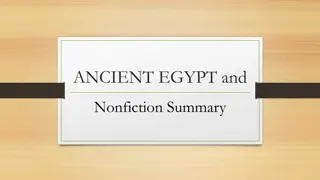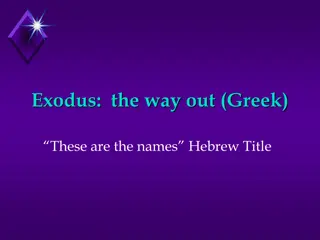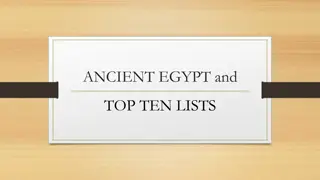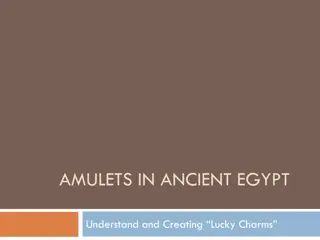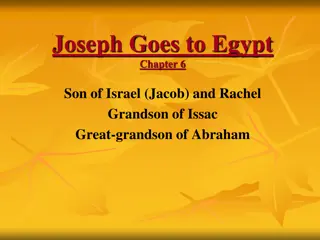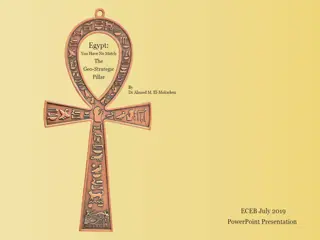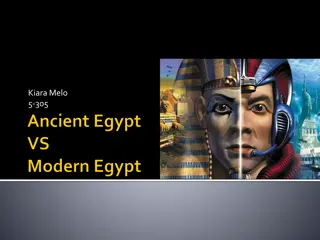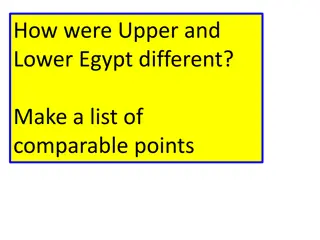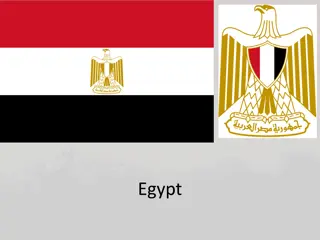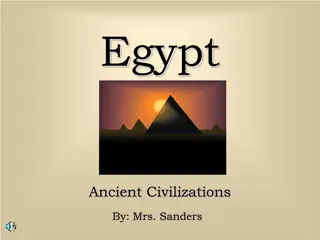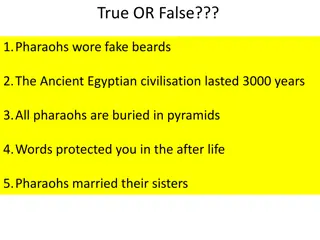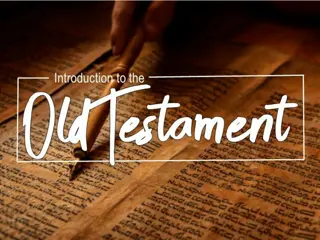Influences and Development of Egyptian Civilization
Connections between Mesopotamia and Egypt in the Predynastic period influenced the early formation of Egyptian civilization. The unification of Upper and Lower Egypt under Narmer marked the beginning of recorded Egyptian history. The dynastic periods shaped the culture and society of ancient Egypt, leading to significant contributions in various fields such as writing, art, religion, and science.
Download Presentation

Please find below an Image/Link to download the presentation.
The content on the website is provided AS IS for your information and personal use only. It may not be sold, licensed, or shared on other websites without obtaining consent from the author.If you encounter any issues during the download, it is possible that the publisher has removed the file from their server.
You are allowed to download the files provided on this website for personal or commercial use, subject to the condition that they are used lawfully. All files are the property of their respective owners.
The content on the website is provided AS IS for your information and personal use only. It may not be sold, licensed, or shared on other websites without obtaining consent from the author.
E N D
Presentation Transcript
Backgrounds to English Literature Lecture 3: Egypt
Connections between Mesopotamia and Egypt -A number of factors indicate that the Predynastic culture of Egypt received some form of stimulation from the emerging city-states of Mesopotamia, particularly during the Uruk period late in the fourth millennium BC. -Typical Mesopotamian items: Palettes, mace heads, cylinder seals, and artistic motifs of interlacing long-necked serpents and men wrestling with large beasts, clay decorations, were found in the Nile Delta. -Even though there was a period of contact between Mesopotamia and Egypt, Egyptian civilization did not develop only as a result of Mesopotamian influence. Before contact with Mesopotamia, Egyptian civilization was already forming on the banks of the Nile River "nails", or coneshaped wall
=Location of Egyptian Civilization -Ancient Egypt, situated in the northeast corner of the African continent, made up part of a vast desert region. -The Nile River: Most of Egypt receives little or no rainfall, and large-scale agriculture would be impossible if not for the Nile River, one of the world's longest and most important rivers. -The common name for ancient Egypt was Kemit, meaning the "Black Land". For the ancient Egyptians black was the colour of life and fertility. -Egypt can be divided into northern and southern sections near what is now the modern city of Cairo. Egypt was referred to as the "Land of the Pharaohs" or the "Two Lands", meaning Upper and Lower Egypt
=The Predynastic period -The period preceding the beginning of Egyptian history, about 3050 BC, is referred to as the Predynastic period. =The unification of Egypt -Egyptologists traditionally mark the beginning of Egyptian history with the unification of Egypt under the rule of a single king, Narmer. Unification of Upper and Lower Egypt. =A list of rulers compiled in 280 B.C. by Manetho for the Macedonians who ruled Egypt. Manetho divided Egyptian kings into thirty dynasties (a 31st was added later) in the following manner.
NAME DYNASTY YEARS Archaic Period 1-2 3100-2700 B.C. Old Kingdom 3-6 2700-2200 B.C. Intermediate Period 7-10 2200-2050 B.C. Middle Kingdom 11-12 2050-1800 B.C. Intermediate Period 13-17 1800-1570 B.C. New Kingdom 18-20 1570-1085 B.C. Post-Empire 21-31 1085-332 B.C.
=Main features of the Egyptian Civilization -Great contributions to the method of writing, literature, art, architecture, religion, science, etc. -Divided day and night into 12 equal divisions and the introduction of the 24-hour day. -Introduction of a 360-day year (5 more days from the Ancient Greeks) -Imhotep, the father of medicine, the concept of documented and systematic medicine. -Basic technological concepts that the world still relies on, including ramps and levers -Among the first civilizations to use mathematical numbers. -Writing system: -Literature: -Religion:
Writing in Egypt -As in Mesopotamia, much of the impetus for early writing in Egypt was for record-keeping and accounting. The earliest representations of Egyptian writing were inscribed on storage jars found at the city of Abydos. These inscriptions appear about 3150 BC. The ancient Egyptians referred to these signs as the medu netcher, the gods' words . -Since the fourth century BC, hieroglyphic or sacred writing. From that time on the word hieroglyph was used by the Greeks to refer to Egyptian writing. -Most texts were written on papyrus or wood using a small brush. Black ink was used for the body of the text and red ink for titles and important passages. this system has been called
Development of the alphabet -A set of letters or symbols in a fixed order used to represent the basic set of speech sounds of a language (OED) -The alphabet is based on the concept that human speech consists of a certain number of basic sounds. These sounds, called "phonemes" by linguists, are the building blocks of all words, either spoken or written, and consist of both consonants and vowels. Since all languages have a limited number of sounds or phonemes, these can be symbolized by a small number of signs or letters, which form an alphabet. -The alphabet was one of the achievements of the First Civilizations. The original concept was Egyptian most impressive and lasting
-The Sinai alphabet: Along with hundreds of hieroglyphs, the Egyptian writing system also contained an alphabet, even though Egyptian scribes never used these signs as such independently. The earliest evidence for a true alphabet was found in the region of the Sinai peninsula, and evidence of this system has also been found in the desert regions to the west of the Nile River. The first traces of this alphabet were left by miners labouring in the copper mines of the Sinai desert for their Egyptian masters. -The Canaanite, or cuneiform, alphabet: One of the earliest alphabets comes from the ancient Canaanite town of Ugarit, which was located on the Mediterranean coast of Syria. This alphabet used symbols drawn from the cuneiform tradition of Mesopotamia. -Greek alphabet -Latin alphabet
The Rosetta Stone -The Rosetta Stone is a rock stele, found in 1799, inscribed with a decree issued at Memphis, Egypt, in 196 BC on behalf of King Ptolemy V. -The decree appears in three scripts: the upper text is Ancient Egyptian hieroglyphs, the middle portion is Demotic script, and the lowest is Ancient Greek. Because it presents essentially the same text in all three scripts (with some minor differences among them), the stone provided the key to the modern understanding of Egyptian hieroglyphs.
Ancient Egyptian Literature -The vast quantity metallurgy, weaving and cooking, legends, adventures, thrilling experiences, religious thought, everyday lists of items, King Lists, stories, poems, and their Book of the Dead, etc. -Ancient Egyptian literature has been preserved on a wide variety of media: papyrus scrolls, packets, limestone or ceramic ostraca, wooden writing boards, monumental stone edifices, and coffins. -They shed lights on the knowledge of their culture and religious beliefs of literature of Ancient Egypt: astrology,
The Tale of Sinuhe =General context -This is a story of Sinuhe, a courier and assistant to the King of Egypt, Amenhotep I. -Importance and popularity: the story survives in many manuscripts through all major periods partly because scribe schools required scribes to copy this text as part of scribal training. the fact that so many scribes worked on copying Sinuhe suggests that it was also studied in all time periods, connecting the Egyptian literate class for 2,000 years. -The oldest manuscripts date to the Twelfth Dynasty (1938 1759 B.C.E. ), also the time of the story s setting. -The scholars still debates whether this is based on a real story or not.
=Literary values -One of the first forms of autobiographical story telling: first person narrator -A virtual compendium of important narrative, eulogy, poetic presentation, letter, song, monologue, etc. -Parallel motifs and narratives: the biblical narrative of Joseph, the Hebrew prophet Jonah, the battle between David and Goliath, the parable of the Prodigal Son, Hamlet. -One of the most iconic pieces of writing in Ancient Egyptian Literature, and its anonymous author is regarded as Egyptian Shakespeare -Influences even on the modern literature: A 20th century CE Finnish writer Mika Waltari wrote a novel called Sinuhe Egyptil inen literary forms: formulaic
=Plot summary -Part 1: Sinuhe is on a military campaign in Libya with Senwosret I, son of the reigning king Amenemhet I. The news of Amenemhet I s assassination reaches the army and Sinuhe panics, fearing that Egypt will fall into turmoil. He is particularly worried that his close connections to the royal family will jeopardize his own life should Senwosret I be denied his legitimate claim to the throne. He decides to flee Egypt, traveling across Egypt s eastern border into the lands beyond. -Part 2: In his haste to leave, he does not pack sufficient provisions and nearly dies of thirst in the desert. A bedouin chief rescues him, and Sinuhe is able to reach the town of Byblos, eventually settling in Upper Retenu in modern Syria. There he meets a local ruler named Amunenshi, who gives him his daughter in marriage and land in a place called Yaa. Sinuhe prospers successfully leads Amunenshi s army against other tribes. in Yaa, has children, and
-Part 3: Near the end of his life, however, he decides he wants to return to Egypt for burial. He sends a letter to the king, and the benevolent Senwosret I welcomes him back to Egypt with full honors despite his cowardly flight years before. Senwosret I arranges for Sinuhe s burial in Egypt, and the final verses describe Sinuhe s tomb and his final contented days in Egypt waiting for death.
=The personal development of Sinuhe -At the start of the story Sinuhe is a coward who deserts his king out of fear of losing his own life. -The real turning point in Sinuhe s life comes when an unnamed hero challenges him to single combat. Though Sinuhe is smaller, he successfully overcomes the hero through physical courage. -With his transformation from cowardly nobleman to victorious hero now complete, Sinuhe is ready to return to his homeland. -Sinuhe moves from disgrace, to renewal, to forgiveness. In the course of this development he also passes from ignorance of his own motives to self-awareness and responsibilities. acknowledgement of his own
=Egyptians attitude towards neighbouring people -The striking feature of Sinuhe's career abroad is his success -When he compares his state at the beginning of the exile with that which he has achieved now, he realizes that the true fame and honour is in the Egypt -After defeating the challenger, he presents this poem: A fugitive flees from his neighborhood, But my fame will be in the Residence. One who should guard creeps off in hunger, But I, I give bread to my neighbor; A man leaves his own land in nakedness, I am one bright in fine linen; A man runs (himself) for lack of his messenger, I am one rich in servants. Good is my home, and wide my domain, [But] what I remember is in the palace.
-Flight from Egypt and Egyptian values is difficult to accomplish and intensely painful. An Egyptian may well succeed in another type of life abroad but his success is hollow, because the greatest triumph there is nothing to a position of modest esteem in Egypt. Eyptian values supplant others. The king is the centre of Egyptian values. -As a Bedouin, Sinuhe had tattered clothes, long hair, and a beard. This look was not acceptable in Egypt as royalty and the upper elites were clean shaven men. =The goodness of the King -The king readily forgives Sinuhe for his disloyalty and welcomes him with open arms, restoring him completely to his former status. -The story established Senwosret s goodness and loyalty to those who remained loyal to him.
Religion in Egypt =Main features -A part in every aspect of the lives of the ancient Egyptians because life on earth was seen as only one part of an eternal journey, and in order to continue that journey after death, one needed to live a life worthy of continuance. -A combination of beliefs and practices: magic, mythology, science, medicine, psychiatry, spiritualism, herbology, belief in a higher power, and a life after death. -Pyramid is the culmination of the Egyptian religion -The notion of the soul: The ancient Egyptians had a profound insight into the various principles that make up the individuality. Ancient Egyptian belief referred to a constituted the individual: kha, ka(double), ba (soul), akh (spirit). -Religion and Kingship -Religion and Morality (Ethics) number of souls that together
=Religion and Kingship -Virtually all Egyptian religious cults are in some sense also designed to focus attention on the royal person. - Offering formula : this phrase occurs at the beginning of lists of types of offerings and consists of the words hetep di nesw ( an offering that the king gives ). -The Narmer Palette
-The Narmer Palette: the overall purpose of the Narmer Palette was to serve as a kind of elaborate reference to the king s role in the act of providing the gods with offerings, which might consist of anything from fruit to slaughtered enemies or prisoners of war. There are a number of constantly repeated iconographic themes in the palette s decoration: first, the king smiting a foreigner, second, the siege and capture of settlements, third, the binding up of prisoners and their execution, and fourth, the offering of the spoils of war to the Egyptian gods. These acts can all be encompassed within a very simple theme in which the role of the Egyptian king was to fight battles on behalf of the gods and then bring back the prisoners and booty to dedicate to the gods in their temples.
=Religion and Morality (Ethics) -The accepted code of social behaviour and the distinction between right and wrong is closely intertwined with funerary beliefs and cultic requirements. -The autobiographies of individuals in the tombs -Ankhtifi, one of the few individuals whose life-story has survived: I am an honest man who has no equal, a man who can talk freely when others are obliged to be silent . . . The whole of Upper Egypt died from hunger and each individual had reached such a state of hunger that he ate his own children. But I refused to see anyone die of hunger in this province. I arranged for grain to be loaned to Upper Egypt and gave to the north grain from Upper Egypt. And I do not think that anything like this has been done by the provincial governors who came before me . .
-Egyptian Book of the Dead 1. The Egyptian Book of the Dead is a collection of spells which enable the soul of the deceased to navigate the afterlife. 2. The Book of the Dead was never codified and no two copies of the work are exactly the same. They were created specifically for each individual who could afford to purchase one as a kind of manual to help them after death 3. After the soul had been justified in the Hall of Truth it passed on to cross over Lily Lake to rest in the Field of Reeds where one would find all that one had lost in life and could enjoy it eternally. In order to reach that paradise, however, one needed to know where to go, how to address certain gods, what to say at certain times, and how to comport one's self in the land of the dead; which is why one would find an afterlife manual extremely useful.
=Egyptian Civilization and Universal questions -Egyptian religion was among the first attempts to answer universal questions: Along with the Sumerians, the Egyptians deliver our earliest though by no means primitive evidence of human thought . . . As far back as the third millennium B.C., the Egyptians were concerned with questions philosophy and that remain unanswered even today questions about being and nonbeing, about the meaning of death, about the nature of cosmos and man, about the essence of time, about the basis of human society and the legitimation of power. that return in later European
Group discussions -Introduce yourself -Decide the note-taker who is also the leader for today -Write down your group number and the names of the member -Questions: 1. Why does the human society need the Ethics ? 2. Discuss the notion of civilization, and each one of you provides its definition in one sentence: Civilization is . . . .
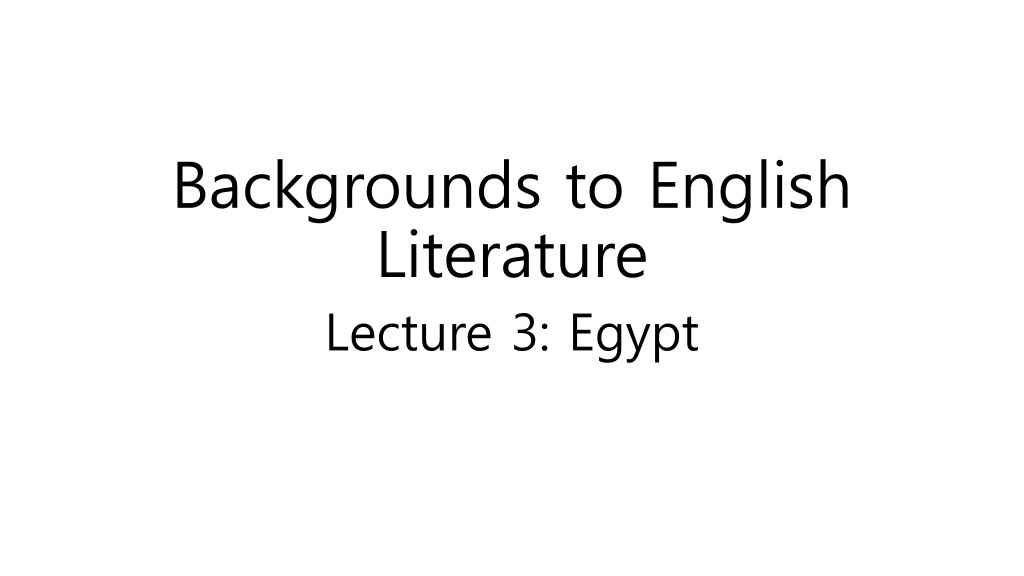



![[PDF⚡READ❤ONLINE] Tutankhamun's Trumpet: Ancient Egypt in 100 Objects from the](/thumb/20549/pdf-read-online-tutankhamun-s-trumpet-ancient-egypt-in-100-objects-from-the.jpg)

